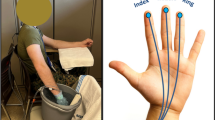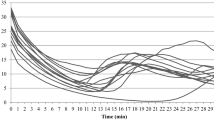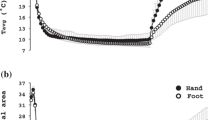Abstract
To study the physiological responses induced by immersing in cold water various areas of the upper limb, 20 subjects immersed either the index finger (T1), hand (T2) or forearm and hand (T3) for 30 min in 5°C water followed by a 15-min recovery period. Skin temperature of the index finger, skin blood flow (Qsk) measured by laser Doppler flowmetry, as well as heart rate (HR) and mean arterial blood pressure (¯BPa) were all monitored during the test. Cutaneous vascular conductance (CVC) was calculated as Qsk / ¯BPa. Cold induced vasodilatation (CIVD) indices were calculated from index finger skin temperature and CVC time courses. The results showed that no differences in temperature, CVC or cardiovascular changes were observed between T2 and T3. During T1, CIVD appeared earlier compared to T2 and T3 [5.90 (SEM 0.32) min in T1 vs 7.95 (SEM 0.86) min in T2 and 9.26 (SEM 0.78) min in T3, P < 0.01]. The HR was unchanged in T1 whereas it increased significantly at the beginning of T2 and T3 [+13 (SEM 2) beats · min−1 in T2 and +15 (SEM 3) beats · min−1 in T3, P < 0.01] and then decreased at the end of the immersion [−12 (SEM 3) beats · min−1 in T2, and −15 (SEM 3) beats · min−1 in T3, P < 0.01]. Moreover, ¯BPaincreased at the beginning of T1 but was lower than in T2 and T3 [+9.3 (SEM 2.5) mmHg in T1, P < 0.05; +20.6 (SEM 2.6) mmHg and 26.5 (SEM 2.8) mmHg in T2 and T3, respectively, P < 0.01]. The rewarming during recovery was faster and higher in T1 compared to T2 and T3. These results showed that general and local physiological responses observed during an upper limb cold water test differed according to the area immersed. Index finger cooling led to earlier and faster CIVD without significant cardiovascular changes, whereas hand or forearm immersion led to a delayed and slower CIVD with a bradycardia at the end of the test.
Similar content being viewed by others
Author information
Authors and Affiliations
Additional information
Accepted: 26 November 1996
Rights and permissions
About this article
Cite this article
Sendowski, I., Savourey, G., Besnard, Y. et al. Cold induced vasodilatation and cardiovascular responses in humans during cold water immersion of various upper limb areas. Eur J Appl Physiol 75, 471–477 (1997). https://doi.org/10.1007/s004210050191
Issue Date:
DOI: https://doi.org/10.1007/s004210050191




